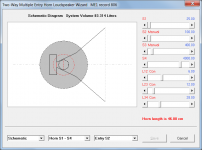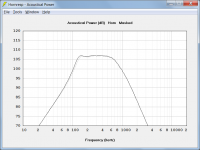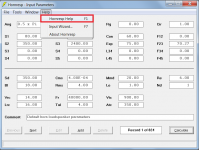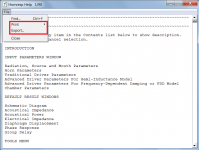Those run here. Just a intuition...can you try to changing damping "Tal/Fr" in Me1 / Me2 input screen to zero, and try again ?
Our dear Santa David added to multiple entry tool the awesome ability to sim damping inside entry ports.
Does it happen with a fresh started hornresp ? It seems hornresp multi-entry keeps sometime opened ME1 / ME2 while changing ME1 / ME2 recording, but everything come back well after hornresp relaunched. (There's sometime too a problem with multiple entry tool putting off some EQ, but i've not token time to see more when it really happens.)
Our dear Santa David added to multiple entry tool the awesome ability to sim damping inside entry ports.
Does it happen with a fresh started hornresp ? It seems hornresp multi-entry keeps sometime opened ME1 / ME2 while changing ME1 / ME2 recording, but everything come back well after hornresp relaunched. (There's sometime too a problem with multiple entry tool putting off some EQ, but i've not token time to see more when it really happens.)
Last edited:
Can you see if this record will run for you?
Hi Josh,
Your test records run just fine for me - see attachment. The records 'arcgotic' provided also worked perfectly. I would love to know what is triggering the error, but until I can experience the problem for myself, there is little I can do about it. For some strange reason, when 'arcgotic' re-imported the exported record files he had sent me, everything worked as it should. Perhaps you could try that also, and let me know the outcome?
One other thought that just occurred to me - if you could sent me a copy of your Hornresp.dat file containing the suspect records (via email) then I could see if they run direct from your data file. It may be that in some way, exporting the record removes the problem. If I can see the original record then perhaps that may tell me something. I would really like to get to the bottom of this frustrating mystery, if I can 🙂.
Kind regards,
David
Attachments
1. I'm not seeing the loudspeaker wizard for single segment exponential horn. Am I missing something or is that the way it is? If it is the latter, can we cheat by adding a 0.01 length second segment? This does allow the loudspeaker wizard to show.
2. In the loudspeaker wizard, could we please get acoustic impedance as one of the results windows?
2. In the loudspeaker wizard, could we please get acoustic impedance as one of the results windows?
Does it happen with a fresh started hornresp ? It seems hornresp multi-entry keeps sometime opened ME1 / ME2 while changing ME1 / ME2 recording, but everything come back well after hornresp relaunched. (There's sometime too a problem with multiple entry tool putting off some EQ, but i've not token time to see more when it really happens.)
Fresh start did not work.
Hi Josh,
Your test records run just fine for me - see attachment. The records 'arcgotic' provided also worked perfectly. I would love to know what is triggering the error, but until I can experience the problem for myself, there is little I can do about it. For some strange reason, when 'arcgotic' re-imported the exported record files he had sent me, everything worked as it should. Perhaps you could try that also, and let me know the outcome?
Kind regards,
David
Re-importing the files worked! I have no idea why.
Thanks guys.
David,
Is there a way to define a vented rear chamber to combinations of the ND, ME1 or ME2 sections? I'm trying to sim an ME2 with a vented rear chamber on both the Me1 and Me2 sections. One of them always reverts back to sealed inside of the wizard, even if defined as vented in the main input screen.
Is there a way to define a vented rear chamber to combinations of the ND, ME1 or ME2 sections? I'm trying to sim an ME2 with a vented rear chamber on both the Me1 and Me2 sections. One of them always reverts back to sealed inside of the wizard, even if defined as vented in the main input screen.
1. I'm not seeing the loudspeaker wizard for single segment exponential horn. Am I missing something or is that the way it is?
That's the way it is.
If it is the latter, can we cheat by adding a 0.01 length second segment?
Yes you can.
2. In the loudspeaker wizard, could we please get acoustic impedance as one of the results windows?
How would the acoustical impedance information be used in the design optimisation process, when already there are power response, electrical impedance, diaphragm displacement, phase response and group delay results to call upon?
Re-importing the files worked!
Hi Josh,
Excellent 🙂.
If it is not too much trouble, I would still be very interested in having a look at the original suspect records in your Hornresp.dat file to see if I can identify what caused the problem in the first place. (Click on my name on the Hornresp download page for my email address).
Kind regards,
David
Is there a way to define a vented rear chamber to combinations of the ND, ME1 or ME2 sections?
No.
I'm trying to sim an ME2 with a vented rear chamber on both the Me1 and Me2 sections. One of them always reverts back to sealed inside of the wizard, even if defined as vented in the main input screen.
In a two-way system ME1 (normally the low frequency section) can have a vented rear chamber, and in a three-way system only ME2 (normally the low frequency section) can have a vented rear chamber.
Sounds like you might have a project for AkAbak... 🙂.
Isn't the acoustical impedance indicative of how well (or not) the horn is coupling to the space outside the horn, or to adjacent stages in the case of a multi-segment horn? Reflections from the mouth will cause ripples in the acoustical impedance seen at the throat.How would the acoustical impedance information be used in the design optimisation process, when already there are power response, electrical impedance, diaphragm displacement, phase response and group delay results to call upon?
Quote from Introduction to Horn Theory - Bjørn KolbrekYou see that the value of mouth impedance will dictate the value of the throat impedance. As explained previously, there will usually be reflections at the mouth, and depending on the phase and magnitude of the reflected wave, it may increase or decrease the throat impedance. A horn with strong reflections will have large variations in throat impedance.
Reflections from the mouth will cause ripples in the acoustical impedance seen at the throat.
Yes, but the ripples in the throat acoustical impedance affect all the other results as well.
The throat impedance is of interest theoretically but is of limited use practically. Essentially all you need to know in the case of an exponential horn for example, is that for a given throat area S1 and flare cutoff frequency F12, the longer the horn, the lower will be the magnitude of the ripples, as shown in the Attachment 1 comparison. The light traces show the impedance for a 100Hz horn of length 90cm and the dark traces show the impedance for the same horn lengthened to 100cm. Obviously the longer horn has smaller ripples, but the chart doesn't really help much in predicting the relative performances of the two systems. Attachment 2 compares the power responses of the two horns, which is a more useful indicator of how they are likely to perform in practice.
From the example given it can be seen that the throat acoustical resistance can vary over wide limits without introducing large variations in the power output.
The acoustical impedance chart was included in the main results because the throat acoustical impedance characteristics of the various flare profiles used in horn loudspeakers can be of interest academically, but it was not considered necessary to also have the chart in the loudspeaker wizard.
Attachments
Last edited:
IMHO the targeted end result is the same, but how one goes about achieving it is going to be different for different people. I like to think that if you can minimise the ripples in the acoustic impedance, you're going to get a better performing horn. Your approach works for horn designs that cover a relatively small frequency range, but try pushing the bandwidth further and you'll see the relationship between acoustic impedance ripple and overall response more clearly. That's my opinion, at least. I'm new to all this, so the likelihood of my being wrong is fairly high.
Hi zgtsang,
The Hornresp.hlp file is opened using the Help menu, or by pressing the F1 function key, as shown in Attachment 1.
Once opened it can be printed, or exported as a text file, as shown in Attachment 2.
Kind regards,
David
The Hornresp.hlp file is opened using the Help menu, or by pressing the F1 function key, as shown in Attachment 1.
Once opened it can be printed, or exported as a text file, as shown in Attachment 2.
Kind regards,
David
Attachments
Good morning David MCBean,Hi zgtsang,
The Hornresp.hlp file is opened using the Help menu, or by pressing the F1 function key, as shown in Attachment 1.
Once opened it can be printed, or exported as a text file, as shown in Attachment 2.
Kind regards,
David
I have a doubt, How can I simulate a line array box in Horn, what methods should I take from the start?
Hi Robson Delight,
Multiple drivers are modelled in Hornresp as a single composite driver.
For this reason it is not possible to accurately simulate a line array using Hornresp.
Kind regards,
David
Multiple drivers are modelled in Hornresp as a single composite driver.
For this reason it is not possible to accurately simulate a line array using Hornresp.
Kind regards,
David
Maybe this is the appropriate place for the question, I seen a formula to convert the poly-fill reading in HornResp to wool once, of course I can't find it now.
I am helping a friend simulating a large BR box using RCF L18P400. WinISD and Hornresp simulate quite differently. I let WinISD optimize a -3dB bass shelf. Box is 283 liter. Port is 327 square cm, 36.4 cm long.
Using a WinISD I get a tuning frequency of 28 Hz, SPL 119 dB with xmax at 38 Hz. Signal is 400 W.
Using Hornresp I get 123 dB SPL with a tuning frequency of 24 Hz. Xmax at 34 Hz. Signal i s 200W.
How can this difference be explained?
Using a WinISD I get a tuning frequency of 28 Hz, SPL 119 dB with xmax at 38 Hz. Signal is 400 W.
Using Hornresp I get 123 dB SPL with a tuning frequency of 24 Hz. Xmax at 34 Hz. Signal i s 200W.
How can this difference be explained?
How can this difference be explained?
Not sure what version of WinISD you are using, but my old copy tells me that for a box volume of 283 litres, a tuning frequency of 28 Hz and a port area of 327 square cm, the vent length should be 28.5 cm, not 36.4 cm.
In Hornresp, for Ang = 2 x Pi, Vrc = 283, Ap = 327 and Lpt = 28.5, the Helmholtz resonance frequency is 28.0 Hz - exactly the same as for WinISD.
Attachments
What are the short comings of HornResp, like what important aspects are not going to show in modelling outside of things like material/thickness used. The resonance's that happen as a result of box geometries, and the affects of a supposed backwave as opposed to geometry adn dampening....that is apart of simulation isn't it?
I exported some IR's from HR into REW the other day, and confused myself more. I always thought the decay chart was a reiteration of the spectrogram. THe IR imports at a much higher SPL, so that changes the results as well.
The IR's in question are a Offset Tapered horn a BR and a MLTL....The spectrogram showed the BR lighting up for much longer than the other two models though they all where un-dampened.
So it caused me to think, quarter wave tuning is less resonant then Helmzholtz resonator tuning regardless of fill material.
You can't export a damped IR in HR so I tried copying the response curve into another program which can turn responses into IR's but then I think....how accurate is this process....and then when I load it into REW its spl is yet a different level than the first 3 though the response was taken at 1watt like everything else in question.
I exported some IR's from HR into REW the other day, and confused myself more. I always thought the decay chart was a reiteration of the spectrogram. THe IR imports at a much higher SPL, so that changes the results as well.
The IR's in question are a Offset Tapered horn a BR and a MLTL....The spectrogram showed the BR lighting up for much longer than the other two models though they all where un-dampened.
So it caused me to think, quarter wave tuning is less resonant then Helmzholtz resonator tuning regardless of fill material.
You can't export a damped IR in HR so I tried copying the response curve into another program which can turn responses into IR's but then I think....how accurate is this process....and then when I load it into REW its spl is yet a different level than the first 3 though the response was taken at 1watt like everything else in question.
I am helping a friend simulating a large BR box using RCF L18P400. WinISD and Hornresp simulate quite differently. I let WinISD optimize a -3dB bass shelf. Box is 283 liter. Port is 327 square cm, 36.4 cm long.
Using a WinISD I get a tuning frequency of 28 Hz, SPL 119 dB with xmax at 38 Hz. Signal is 400 W.
Using Hornresp I get 123 dB SPL with a tuning frequency of 24 Hz. Xmax at 34 Hz. Signal i s 200W.
How can this difference be explained?
Have you tried modeling a negative flare tapped horn. I'm thinking you can get better performance within that same 283 liters. In their simplest form, a TH has 7 boards just like a BR. And, the T-TQWT will sound better!
- Home
- Loudspeakers
- Subwoofers
- Hornresp







